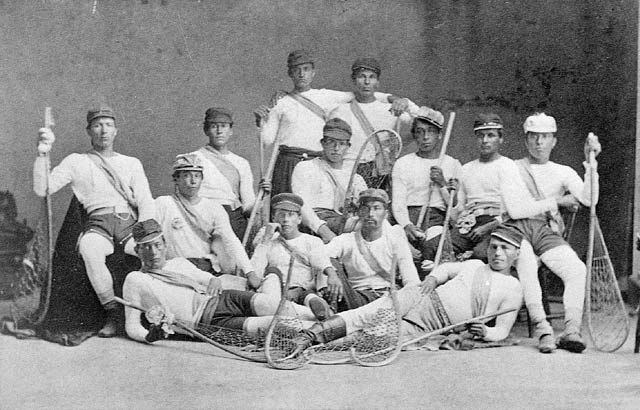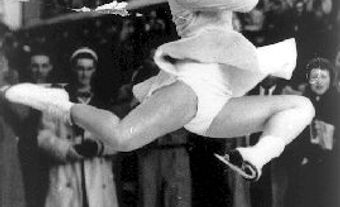
The earliest illustration of a LACROSSE stick dates back to 1790, when Italian explorer Count Paolo Andreani, who was travelling in what is now upstate New York, sketched a lacrosse stick in his journal. The accompanying notation describes the stick as a "kind of racket, about 4 feet, 6 inches long, which in the lower end curves considerable; thus resembling the string of a bow, it serves to throw the ball." The oldest museum examples of lacrosse sticks date back to the 1820s.
Traditional lacrosse sticks are made of a single piece of wood, bent to form the head of the stick (the part used for catching, carrying, and throwing the ball). Traditionally, Indigenous stick makers wrapped pliable steamed hickory around a tree in order to bend it. More recent wooden lacrosse stick makers, such as Onondaga craftsman Alf Jacques, bent the wood using a specially designed steel plate as a fulcrum. The bend was then held in position by a piece of wire, and the stick was set aside to dry, which often took several months.
Traditional lacrosse sticks fall into two main categories: those with pockets enclosed by wood and those with unenclosed pockets. The pockets of the enclosed variety were quite small. Because of this, enclosed sticks were often used in pairs (one atop the other to contain the ball), although they were sometimes used on their own.
In the southeastern style of play (such as Cherokee, Seminole, and Choctaw), players used two sticks, one in each hand. The pouch in the oval-shaped pocket was formed by a string running lengthwise intersecting with a string running crosswise. Often, the pocket of one stick was slightly smaller than that of the other, allowing the smaller pocket to fit inside the bigger one to more effectively secure the ball. Southeastern sticks were also rather short, ranging from 0.6 metres to 0.8 metres in length, with the smaller-pocketed stick a centimetre or so shorter. Since many players made their own sticks, however, variations in size were common. In the Eastern Cherokee version of the game, the sticks were identical in size and length, and players held their sticks as close to the body as possible with one hand.
Indigenous groups in the areas surrounding the western Great Lakes also used a stick with an enclosed pocket but, unlike the southeastern players, the Great Lakes players used a single stick that was slightly longer than the southeastern stick (averaging about 0.9 metres in length). The pocket of the Great Lakes stick was completely round, with the strings that supported the ball running from the outside of the circular ring to a point in the centre of the pouch.
The unenclosed style of stick, the Iroquois stick, was more common in the northeast, on both sides of the St Lawrence River. This rather large stick is the basis for the modern lacrosse stick. Unlike the Great Lakes and southeastern versions of the stick, these northeastern sticks were not enclosed by wood, but a by a piece of string that ran from the end of the bend to the beginning of the bend. String or rawhide weaving made a very shallow pouch to contain the ball. Over time the pocket became more defined (and eventually enclosed) and the webbing became more taut. To keep the ball in the pouch, players cradled the ball (rocked it back and forth within the woven area), something that was likely a lot more challenging with the older style of stick than with the modern version. Sticks used in modern-day women's field lacrosse still have a very shallow pouch, so in that respect, are more similar to the traditional Indigenous sticks than are other modern sticks.
Wooden sticks are becoming a rarity and are considered illegal by many modern lacrosse associations. The rules of the National Lacrosse League, a league comprising teams from both the United States and Canada, dictate that sticks be made from hollow synthetic or metal type material, with the head attached directly to the shaft.

 Share on Facebook
Share on Facebook Share on X
Share on X Share by Email
Share by Email Share on Google Classroom
Share on Google Classroom



